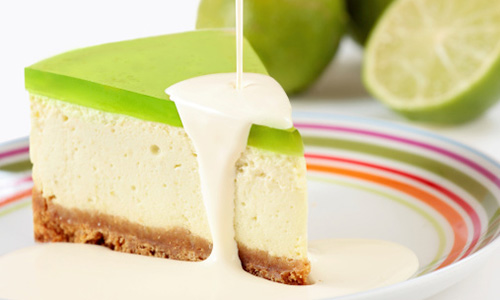
Ingredients for approx. 16 slices:
- 75 g butter
- 100 g butter biscuits
- 50 g Amaretti biscuits
- 6 + 3 gelatine sheets or 9 + 5 g of powdered gelatine
- approx. 4 limes
- 200 g cream cheese
- 150 g whole milk yogurt
- 75 g + 2 tbsp sugar
- 50 g liquid honey
- 300 g cream
- 1 sachet of vanilla sugar
- 200 ml white wine
In addition:
- A few drops of green food colouring
- Some oil for the springform pan
Preparation:
- Grease sides of the springform pan (26 cm Ø) with a little oil. Melt butter on a low heat. Place all of the biscuits in a freezer bag, close bag and finely crumble biscuits with a rolling pin. Then mix crumbs with the melted butter and press into the springform pan to make a base. Cool for approx. 1 hour.
- Soak 6 sheets of gelatine in cold water. Cut limes in half and squeeze out juice. Mix cream cheese with yogurt, 75 g sugar, honey and 75 ml lime juice. Whip cream together with the vanilla sugar.
- Squeeze out gelatine and dissolve on a low heat. Stir 2 tablespoons of the cream cheese mixture into the gelatine and then combine with the rest of the mixture. Fold whipped cream under and spread the cream mixture onto the cake base. Refrigerate for approx. 4 hours.
- In the meantime, soak remaining gelatine in cold water. Heat 50 ml lime juice, white wine and 2 tablespoons of sugar until the sugar has dissolved. Squeeze out gelatine and dissolve in the juice mixture. Add food colouring and let mixture somewhat cool before drizzling it over the cream. Again chill cake for approx. 1 hour. Tip: cake is delicious when served with vanilla sauce!
Click here for more information on cooking and baking with gelatine.
Approx. nutrition facts per serving:
- Calories: 243
- Joules: 1017
- Protein: 5.1 g
- Fat: 16.0 g
- Carbohydrates: 17.3 g
Limes – small, green and full of vitamins
As summer comes ever closer and the temperatures slowly begin to rise, so does the desire for sweet refreshments. Even though limes can be bought in the fruit sections of supermarkets year round, May marks the beginning of the high season for the green citrus fruits. Their juice and peel give cakes and desserts a refreshing, summery taste. The small green power fruit is, however, not only a useful ingredient because of its flavour – it also strengthens our immune system and, through this, makes us shine! After all, 100 g of lime (44 mg/100 g fruit) supplies almost half the daily required amount of vitamin C. Similar to vitamin E, which can also be found in limes, vitamin C has anti-oxidative properties. It protects our cells and, in doing so, keeps us young and healthy!
The lime is a close relative of the lemon. Although it is smaller in size than its yellow sister, it contains a great deal of juice and also has fewer seeds. Its flesh is light green in colour and it has a hard peel that is, however, relatively thin. This means that its flesh will dry out fairly quickly. Fruit stored at room temperature will often become hard after only five days and thus provide less juice. Limes are better stored in a cool and slightly damp room (10°C) – this will keep them fresh for up to four weeks!
Important: even fruits labelled with “untreated” or “peel suitable for consumption” should be washed in hot water before use. Although fruits bearing such a label will in fact be free of pesticides and other plant protection products, their peel will still have been coated with wax to increase their shelf-life. When buying limes, make sure that they are not too dark green in colour; this may be a sign of an unpleasantly sour flavour. Glossy, vibrantly light green fruit, on the other hand, are ripe and flavourful. Perfect for a fresh, summery lime pie!
Enjoy!